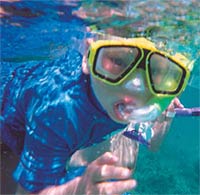Parks VICTORIA
Enjoying Victoria's Marine National Parks and Marine Sanctuaries |
 |
| |
What you're likely to see
|
Many of Victoria's outstanding dive sites, including those in southern Port Phillip Bay, at Wilsons Promontory and at Port Campbell, have now been protected within Marine National Park and Marine Sanctuary boundaries, for current and future generations of dive and snorkel enthusiasts to enjoy.
The southern end of Port Phillip Bay is already an internationally recognised dive area, and the Port Phillip Heads Marine National Park will further enhance diving opportunities within easy access of Melbourne, Geelong and the Mornington and Bellarine Peninsulas. In the Rip spectacular wall diving and exciting drift dives can be experienced by appropriately qualified divers with some outstanding invertebrate life, rivalling the colour and diversity seen on tropical coral reefs. Sheltered Rockpools at Point Lonsdale and Point Nepean provide beginner and experienced snorkellers with an opportunity to experience Victoria's underwater life in relative ease.
|
 |
Pope's Eye is a popular tourist destination for snorkelling, scuba diving, underwater photography, bird watching, and for education programs. While originally intended to become a part of the fortifications of the Heads back in the late 1800's, the area has enjoyed full protection for over two decades and the consequent abundance of marine life has to be seen to be believed.
Despite its small size, more than 30 dive and snorkelling operators (mainly from the southern end of the bay at Portsea, Sorrento and Queenscliff) regularly use Pope's Eye because of its relatively easy access and the amazing diversity of marine animals and plants. Nearby Portsea Hole is another great deeper dive location located in the old Yarra River bed.
Marine National Parks at Wilsons Promontory, Twelve Apostles, Cape Howe, Point Hicks, Ninety Mile Beach, Corner Inlet, Bunurong, Western Port, Point Addis and Discovery Bay can be added to the list of wonderful dive locations.

Pink Jewel anemone
|
Many of the smaller Marine Sanctuaries have also been protected for their value to snorkellers and divers. The coastal reefs at Barwon Bluff, Beware Reef, Point Danger, Marengo near Apollo Bay, Rickets Point and The Jawbone in Port Phillip Bay, the islands at Merri near Warrnambool, Mushroom Reef in Westernport, and the Arches near Port Campbell, all provide great opportunities for both snorkellers and divers to experience Victoria's stunning underwater scenery and unique animals and plants.
In the absence of fishing and other extractive uses, the habitats in the Marine National Parks and Marine Sanctuaries will remain intact, allowing the size, diversity and abundance of fish and other species to increase, all adding to the enjoyment of the dive experience. |
Some of Victoria's most notable shipwrecks also lie within these protected areas, especially in the waters off Port Phillip Heads, Wilsons Promontory and Point Hicks. For instance, Lonsdale Reef near Point Lonsdale has at least four visible and recognisable shipwrecks - the iron sailing barques George Roper, Holyhead and Gange, and the gold rush steamer Conside.
Personal and environmental care
As users of our Victoria's Marine National Parks and Marine Sanctuaries you can minimise your impact while enjoying yourself by keeping in mind the following points:
- enjoy the marine environment without removing the plants and animals
- minimise your impact while diving and snorkelling by:
- being careful to avoid damage to marine life caused by fins
- developing good skills in buoyancy control
- securing all gauges and pressure hoses to avoid snagging them on objects
- take any rubbish home with you - do not dump rubbish into the sea
- avoid stressing marine life by not chasing or grabbing free-swimming animals
- exercise great care if approached by large marine animals (including birds) and avoid blocking their paths if moving
- take care where you anchor your boat (anchor in sand, rubble or mud, avoiding sensitive areas, and use mooring buoys where provided)
- do not pollute the water with sewage - ensure that if your vessel has an on-board toilet that it has an approved sewage holding facility and that sewage is disposed of appropriately on land
- take the time to learn more about Victoria's marine animals and plants and the habitats they depend upon
- be aware that a number of marine animals are potentially harmful if not treated with respect and care, so ensure that you familiarise yourself with these species minimise your impact on the sea by disposing of waste materials at home or work appropriately
Remember, Marine National Parks and Marine Sanctuaries are NO TAKE ENVIRONMENTS. All objects (artefacts), animals including fish and crustaceans, plants, and the seabed are totally protected.
- SCUBA diving is a potentially high-risk activity and should only be undertaken by appropriately qualified people that have completed recognised training and certification. Victoria's cool water environments can be extremely challenging to those used to diving in warmer waters so ensure that local knowledge is sought before undertaking a dive. in a new location. Dive charter operators can provide some of the best advice on diving in Victoria.
- For your own safety, only undertake activities appropriate to your skills and abilities. Take all necessary precautions, be aware of changing conditions, and watch for potential hazards, such as rips.
A number of licensed tour operators conduct recreational and educational activities in and around the parks and sanctuaries.
For your safety, only undertake activities appropriate to your skills and abilities. Take all necessary precautions, be aware of changing conditions, and watch for potential hazards. |
 |
No fishing, netting, spearing, taking
or killing of marine life.
All methods of fishing, from the shore
or at the sea, are prohibited. |
 |
No taking or damaging of animals,
plants and objects (artefacts). |
|
|
Next: Teaching Ideas
|